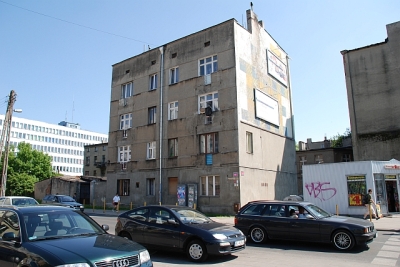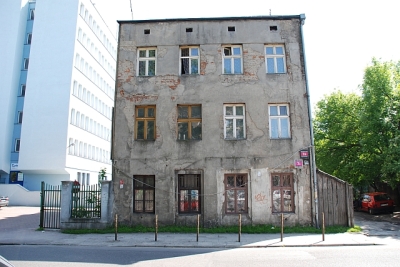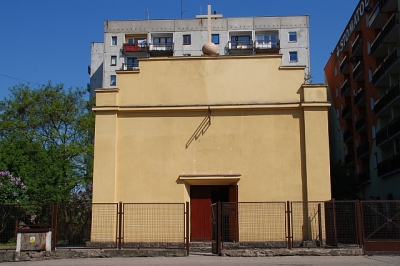Dworska Street began next to Balucki Rynek. Key ghetto offices and institutions were located in the buildings surrounding the square. Chronicler Oskar Singer called Dworska Street the artery, or even the stomach of the ghetto, since it housed the most important departments: the Supplies Department, the Kitchens Department, the Transport Department and the Dairy Headquarters.
 The building that still exists at 1/3 Dworska St. housed the Secretariat for Requests and Complaints. With the passing of time, the Presidium Department, also known as the Presidium Secretariat, which performed many official and technical functions, was shifted to this building from 4 Plac Koscielny. Its responsibility was not only editing and announcing Rumkowski's orders, but also issuing identity cards. The Main Bookkeeping Office, the Insurance Section, the Information Section and, for some time, also the High Chamber of Control operated in the same building. Beginning in April 1940, a branch of the Main Post Office was located here as well.
The building that still exists at 1/3 Dworska St. housed the Secretariat for Requests and Complaints. With the passing of time, the Presidium Department, also known as the Presidium Secretariat, which performed many official and technical functions, was shifted to this building from 4 Plac Koscielny. Its responsibility was not only editing and announcing Rumkowski's orders, but also issuing identity cards. The Main Bookkeeping Office, the Insurance Section, the Information Section and, for some time, also the High Chamber of Control operated in the same building. Beginning in April 1940, a branch of the Main Post Office was located here as well.
The Coal Department office was located on the opposite side of the street, in a dilapidating one-storey wooden building. It was established as early as May 8, 1940, days after the ghetto had been sealed off. Wood, coal and peat were gathered in a large square behind the building.
 The fuel was supplied from Balucki Rynek or from Radogoszcz Station. In winter season, the coal depot would hand out 2 million kilograms of coal a month. Today apartment blocks now occupy the site. The area has changed considerably.
The fuel was supplied from Balucki Rynek or from Radogoszcz Station. In winter season, the coal depot would hand out 2 million kilograms of coal a month. Today apartment blocks now occupy the site. The area has changed considerably.
At 6 Dworska St. was the Collonial Food Commodities and Bread Section; the Kitchens Section operated at 20 Dworska St. Neither structure exists today, nor the tenement building at 5 Dworska St. where the kitchen of the Supplies Department and other offices were located. However, the building that housed the transport department at 7 Dworska St. and the Augsburg Evangelic Chapel at the corner of Lagiewnicka Street, which now today is the Methodist Church (2 Organizacji WiN Street) survived the war.
Balucki Rynek, a dirty square in the filthiest part of Lodz, is now the heart and brains of the ghetto. The ghetto artery, Matrosengasse [or Dworska Street], flows into it. Here the important administration departments - the Central Secretariat, the Kitchens Department, the Transport Department, the Dairy Headquarters are gradually establishing their work sites. The Supplies Department, the stomach of the ghetto, is also located here, with a filthy square at the corner of Matrosen and Hanseatenstrasse abutting it. The Chairman passes it to his co-worker Lazar Naumann: "This is your kingdom! Fill it with coal and wood, we must cook and we need warmth."
Oskar Singer, Quickly Walking through the Ghetto, p. 74.
The workers of the Coal Department are wearing uniforms, just as the Order Service or the fire brigade does. They wear caps and official armbands with Coal Department emblems on their arms. Insignia on their caps. A plain worker wears a yellow armband with his number. The group leaders wear a yellow and silver one, and the administration officers are marked with two silver and one yellow stripe.
Oskar Singer, Quickly Walking through the Ghetto, p. 79.
Today I have an appointment at 11 a. m. with Waks and Rozenberg at 1 Dworska St., to go and see Franek in the Personnel Department. After a long wait Rozenberg arrived, but no sign of Waks.
Jehuda Lubinski, The Diary Found in Baluty, p. 402.
 Last week the German authorities ordered to empty the Trinity Church (2 Dworska St.) be emptied of its benches and other equipment, which were later taken away to the city via Balucki Rynek. The church building was assigned to be a depot for materials used for making sheepskin coats for the army. It is worth adding that all other churches within the ghetto have been closed since the first days, constituting a kind of foreign property excluded from the ghetto.
Last week the German authorities ordered to empty the Trinity Church (2 Dworska St.) be emptied of its benches and other equipment, which were later taken away to the city via Balucki Rynek. The church building was assigned to be a depot for materials used for making sheepskin coats for the army. It is worth adding that all other churches within the ghetto have been closed since the first days, constituting a kind of foreign property excluded from the ghetto.
The Chronicle of the Lodz Ghetto, December 21, 1941, p. 330.
According to information from the Kitchens Department at 20 Dworska St., soup kitchens No. 302, 322, 348, 363, 415, 434 and 451 will be closed on the 9th. The reason given by the Kitchens Department is a great decrease in the number of consumers. In the soup kitchen at 26 Zgierska St. it decreased from about 1,800 during the holiday season to 120.
The Chronicle of the Lodz Ghetto, December 21, 1941, p. 330.

 Home
Home
